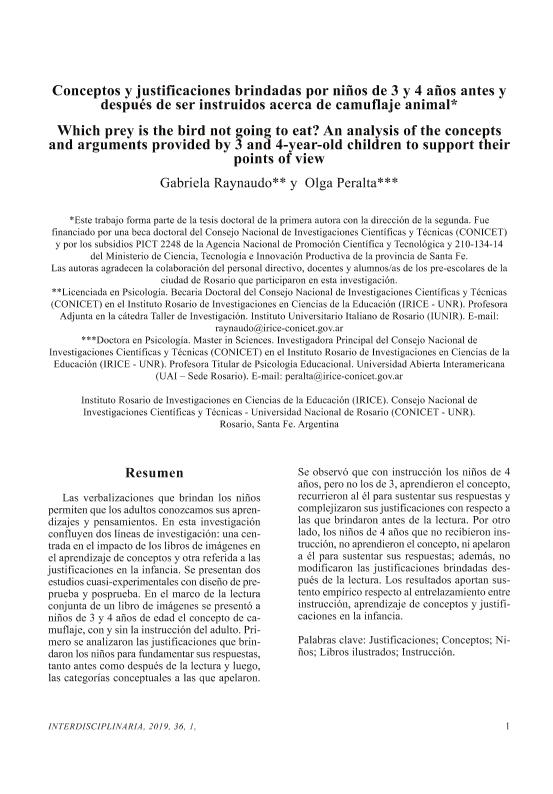Artículo
Las verbalizaciones que brindan los niños permiten que los adultos conozcamos sus aprendizajes y pensamientos. En esta investigación confluyen dos líneas de investigación: una centrada en el impacto de los libros de imágenes en el aprendizaje de conceptos y otra referida a las justificaciones en la infancia. Se presentan dos estudios cuasi-experimentales con diseño de preprueba y posprueba. En el marco de la lectura conjunta de un libro de imágenes se presentó a niños de 3 y 4 años de edad el concepto de camuflaje, con y sin la instrucción del adulto. Primero se analizaron las justificaciones que brindaron los niños para fundamentar sus respuestas, tanto antes como después de la lectura y luego, las categorías conceptuales a las que apelaron. Se observó que con instrucción los niños de 4 años, pero no los de 3, aprendieron el concepto, recurrieron al él para sustentar sus respuestas y complejizaron sus justificaciones con respecto a las que brindaron antes de la lectura. Por otro lado, los niños de 4 años que no recibieron instrucción, no aprendieron el concepto, ni apelaron a él para sustentar sus respuestas; además, no modificaron las justificaciones brindadas después de la lectura. Los resultados aportan sustento empírico respecto al entrelazamiento entre instrucción, aprendizaje de conceptos y justificaciones en la infancia. Children's verbalizations provide a glimpse into their thoughts and learning processes. This research arises in the intersection of two fields: the impact of picture-books in conceptual and- justification learning. Dialogic picture-book reading is a widespread practice between children and adults. The main goal of this research was to analyze the verbalizations children gave before and after the exposition to the concept of camouflage using a picture-book. We designed two studies using a quasi-experimental pre-test post-test approach. In Study 1 we compared two age group-children: 3- and 4-years-olds. Both groups were exposed to the concept of camouflage guided by the instruction of an adult using a picture-book. We considered camouflage as the ability of some animals to blend with the environment to avoid being seen by predators. By instruction, we meant the information given by the adult using examples of animals. The animals were shown in camouflaged and non-camouflaged settings and the adult explained which prey the predator could not eat based on the color of the animal and the background. The picture-book used was specially constructed for this research. It consisted of 10 pages; the first two showed a photograph of a predator (an eagle). The next eight pages showed four different preys depicted in camouflaged and no-camouflaged settings. In the pre-test and the post-test children were asked to choose which prey the depredator will not eat. Children also had to support their answers by explaining why the bird will not eat the chosen prey. We analyzed children’s answers and the explanation that they gave before and after the exposition to the concept of camouflage with the picture-book. Additionally, we analyzed the justifications and the conceptual categories that children used to support their choices. The justifications were inspired in Migdalek’s work (e.g. Migdalek, Rosemberg & Santibanez, 2014). The conceptual categories were created inductively from the transcription of children’s verbalizations. We found that the 4-years-olds learned the concept and support their choices appealing to the camouflage category; also, they provided complex justifications. As far as 3-years-olds, even though they received the same instruction, they did not learn the concept, neither improved their justifications. Given these results, we concluded that the observed differences in the performance are due to the children’s age, since the instruction provided was the same for the two age groups. To specifically explore the impact of the instruction we designed a Study 2 in which we compared children’s answers and their verbalizations in two groups of 4-year-old children. Four-years-old were exposed to the same picture-book with and without instruction. The procedure followed was the one described in Study 1. In the condition without instruction, the experimenter presented the children the picture- book indicating which prey the depredator would not eat, but without explaining the reasons. We found out that the children that did not receive any instruction did not learn the concept or used it to support their choices. Besides, this group did not improve their justifications. In contrast, the children that received instruction learned the concept and supported their choices using the camouflage category; in addition, they provided complex justifications. Overall, the results presented provided empirical data to highlight the close relationship between instruction, conceptual learning and justifying in children.
Conceptos y justificaciones brindadas por niños de 3 y 4 años antes y después de ser instruidos acerca de camuflaje animal
Título:
Which prey is the bird not going to eat? An analysis of the concepts and arguments provided by 3 and 4-year-old children to support their points of view
Fecha de publicación:
05/2019
Editorial:
Consejo Nacional de Investigaciones Científicas y Técnicas. Centro Interamericano de Investigaciones Psicológicas y Ciencias Afines
Revista:
Interdisciplinaria
ISSN:
1668-7027
Idioma:
Español
Tipo de recurso:
Artículo publicado
Clasificación temática:
Resumen
Palabras clave:
JUSTIFICACIONES
,
CONCEPTOS
,
NIÑOS
,
LIBROS ILUSTRADOS
Archivos asociados
Licencia
Identificadores
Colecciones
Articulos(IRICE)
Articulos de INST.ROSARIO DE INVEST.EN CS.DE LA EDUC. (I)
Articulos de INST.ROSARIO DE INVEST.EN CS.DE LA EDUC. (I)
Citación
Raynaudo, Gabriela Maria; Peralta, Olga Alicia; Conceptos y justificaciones brindadas por niños de 3 y 4 años antes y después de ser instruidos acerca de camuflaje animal; Consejo Nacional de Investigaciones Científicas y Técnicas. Centro Interamericano de Investigaciones Psicológicas y Ciencias Afines; Interdisciplinaria; 36; 1; 5-2019; 1-16
Compartir




